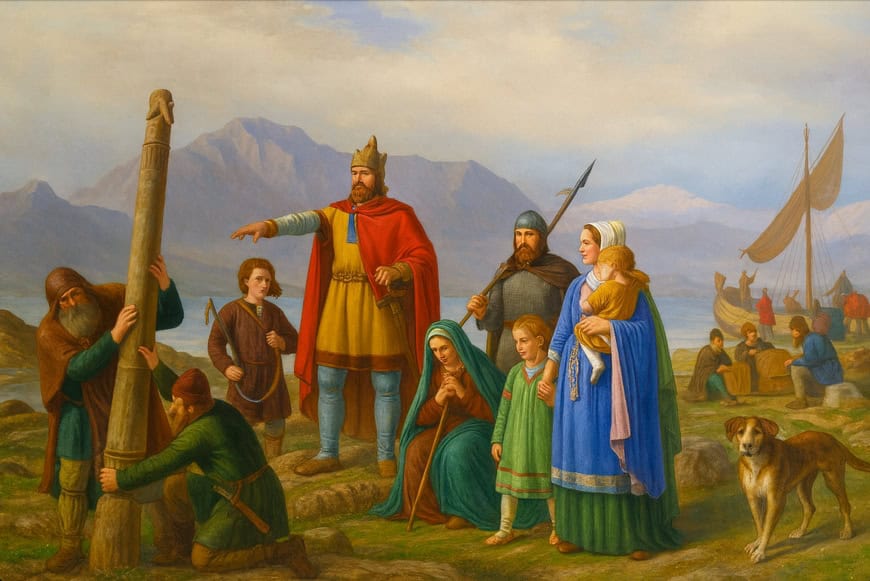I just returned from ten days in Iceland, drawn by the geology and stark beauty. What I found was more than scenery—it was a case history in climate change, collapse, and fossil-fueled resurrection. A treeless island made marginally habitable by a warm climate window became the setting for a long struggle against cold, isolation, and structural poverty. Today it’s held up as a model of clean energy and resilience. But look closer, and the foundations are older, deeper, and far more uncertain.
The settlement of Iceland in the 9th century wasn’t some bold Viking conquest. It was a reaction to desperate times. Norway’s elites were consolidating power, led by Harald Fairhair, who declared himself king after the Battle of Hafrsfjord around 872. Rival chieftains were forced out. So were landless men and independent farmers. With primogeniture locking up property and too many mouths to feed, many left. Some went to the British Isles. Others sailed west, toward open water and a less certain future. Among them was Ingólfur Arnarson, who landed at what became Reykjavík. He wasn’t a raider. He was a refugee.

Figure 1. Ingólfr Arnarson, the first settler of Iceland, newly arrived in Reykjavík in 874. Source: Labyrinth Consulting Services, Inc. after a painting by Peter Raadsig (1850). Click on the image to enlarge.
|
This wave of migration didn’t happen in a vacuum. It was enabled by climate change. The so-called Medieval Warm Period—roughly 800 to 1300—brought longer summers, retreating sea ice, and just enough land to farm in remote areas of the North Atlantic. A hiatus in volcanic activity, stronger AMOC circulation, and higher solar output combined to open a temporary window. Iceland, Greenland, even Vinland (likely Newfoundland) weren’t plundered—they were settled, with livestock, hayseed, and slaves. This was agricultural expansion, not conquest.
But Iceland was never easy. No grain. No metal. Almost no trees. The settlers quickly deforested what little there was, exhausted fragile soils, and locked themselves into a bleak subsistence of hay, sheep, fish, and prayer. It held together—barely—until the climate turned against them. Around 1300, the Little Ice Age began. Sea ice returned. Growing seasons shortened. Glaciers advanced. Greenland was abandoned. Iceland entered centuries of famine and disease, not to mention devastating volcanic eruptions.

Figure 2. The Medieval Warm Period and the Little Ice Age. Source: Labyrinth Consulting Services, Inc. after edsimoneit.blog. Click on the image to enlarge.
|
The Black Death reached Iceland in the early 1400s and returned near the end of that century.
From the 14th century on, Iceland was a colony of Denmark, locked into a system of shareholder agriculture. A small class of landowners—often tied to Danish elites—controlled nearly all the land. Most Icelanders were tenant farmers or indentured laborers. The Danish Crown enforced a trade monopoly from the 1600s on, banning commerce outside licensed regions. Prices were fixed. Icelanders needed permission to own boats. The fishing industry remained small and seasonal. Life expectancy was short. Infant mortality was high. The vast majority lived in turf houses, barely surviving with limited crops and salted fish. Iceland wasn’t poor only because it was cold. It was poor because it was also controlled.
Things began to change in the 19th century. The Little Ice Age weakened. Denmark loosened its grip. Iceland was granted limited home rule in 1874, more in 1904. Cooperatives formed. Small fishing operations emerged. Reykjavík grew slowly. But the country remained overwhelmingly rural and poor. As late as the 1930s, most people had no electricity, no roads, no modern tools. It was a subsistence economy with limited exports. Iceland was one of the poorest countries in Europe by the middle of the 20th century.
Then everything changed.
During World War II, the British and then the Americans occupied Iceland. With the troops came roads, wages, hospitals, and infrastructure. Icelanders were paid to build airfields and feed the troops. For the first time, there was steady cash income, regular work, and exposure to modern goods and services. When the war ended, the Marshall Plan poured money into ports, fishing fleets, hydropower, and education. Iceland became fully independent in 1944.
Cheap fossil fuels did the rest. The fishing industry scaled up. Hydropower and geothermal capacity expanded. Roads reached into the interior. Trade networks opened. The state took an active role—investing in schools, infrastructure, and resource management. Fisheries were regulated. The economy diversified. In the 2000s, tourism boomed, sold to the world as wilderness and purity—flown in by kerosene, propped up by public investment, and sustained by global demand.
Today, Iceland has a higher per capital GDP than the U.S. and E.U. But its prosperity isn’t post-carbon. It runs on fossil-fueled trade, imported goods, and oil-powered jets and cruise ships. Nearly all its food is flown or shipped in except seafood which it exports by petroleum-powered ships and aircraft. Its aluminum smelters rely on hydro—but only because global fossil capitalism makes bauxite mining, and shipping profitable through 6-continent supply chains. The geothermal heat is local. The prosperity is not.
Iceland is a case study in strategic leverage. It took what it had—hydro, fish, hot water, scenery—and made it work. With competent governance and timely additions of outside energy and capital, it rose from subsistence poverty to modern affluence in a single generation. But this wasn’t a departure from the fossil era. It was one of its cleaner-looking artifacts.
The miracle is real, but like every fossil-fueled success, it rests on the unstable foundation of cheap, abundant oil. Iceland is fully integrated into the global superorganism—thriving when the system runs smoothly, exposed when it bends, finished when it breaks.
|
ABOUT THE AUTHOR
Art Berman is Director of Labyrinth Consulting Services, Sugar Land, Texas, and a world-renowned energy consultant with expertise based on over 40 years of experience working as a petroleum geologist. Visit his website, Shattering Energy Myths: One Fact at a Time, and learn more about Art here.
|